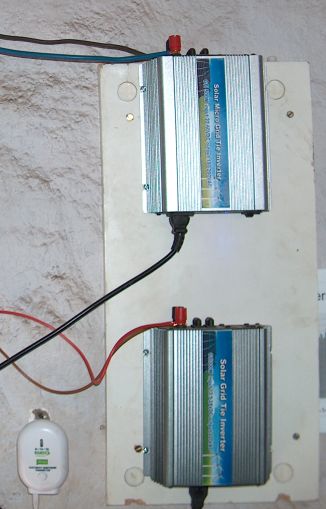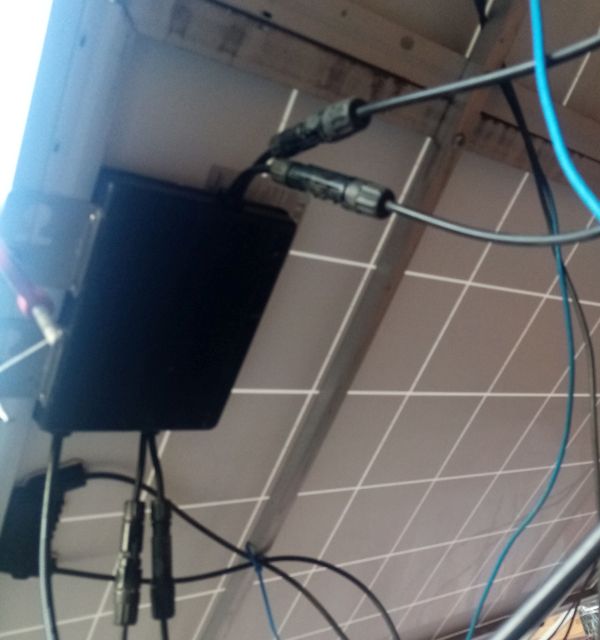

Grid Tie Inverters - Converting solar energy to useful electricity
A really impressive technology is developing at present relating to the useful conversions of solar energy.
Solar panel electrical characteristics
Solar panels are becoming quite cheap and have a long
operating life (20 years if well made). However they are
difficult to interface to harness the available power. A
typical panel might have an open circuit voltage of 38 volts,
a short circuit current of 8 amps and have an optimum
power transfer point elsewhere say at 31 volts. In addition
a cloud passing across the direct sun path might cause the output
power to drop to just 10% of the energy compared to the energy
without the cloud. All this means that one is getting continually
fluctuating energy from the panels and it is very difficult to
design for a steady load- especially something using a motor.
In the past one might have stored the energy in some form of battery, but this gives very little of the potential energy available from the solar panel to a useful load. Batteries are expensive, difficult to charge and discharge quickly, have small capacities and a limited life.
Converting solar energy to mains energy
The ideal situation is to immediately convert the solar energy
to mains electricity that is compatible with the supplied mains and
to use the energy in the normal AC load of the building, reducing
the amount of energy drawn from the municipal supply.
Note-You cannot use any inverter to convert the DC voltage from the solar panel to AC mains compatible energy. It has to be generated in EXACT phase and frequency with the incoming mains otherwise the mains energy is going to vaporised the inverter.
The type of inverter needed is called a Grid-Tie inverter.

It starts its inverter at the same frequency as the incoming mains supply but at a low output voltage and gets the two voltages in exact phase with each other. It then increases the output voltage to start supplying in phase electricity and using up the available solar power.
On the solar input side it adjusts the load voltage to get maximum power transfer from the solar panel by monitoring the DC voltage and current to operate at the Maximum Power transfer point. It continually adjusts these values so that it can handle variations in the available solar power such as might happen with a cloud passing through the direct sun path.
The inverter has another feature called islanding, which shuts down the entire process in the event of an incoming mains failure or if the phase angle of the mains differs slightly from that of the inverter. Shutdown happens instantaneously and sequence restarts.
Grid-Tie inverters have been around for a long time for major solar and wind turbine installations. They have however been quite expensive.

The new development is in the form of micro grid-tie inverters which allow simple systems of 300 watts to 600 watts to be implemented in modular form. These are not wired into the main switch board of the establishment, but plug into a normal AC outlet in a room. They are also cascadable allowing many 300 watt or 600 watt units to work in parallel so that larger loads can be addressed. They cost less than R2000 each.
Different voltage ranges
The micro grid tie inverter can work with a single solar panel or a cluster of panels wired in parallel giving up to 600 watts of solar energy per module. Different voltage ranges are available allowing them to be designed to work with 12 volt, 24 volt or 48 volt solar systems.
The advantage with lower voltage small systems is that they are safer for the DIY enthusiast,
you can start your system with a small working system and expand as your needs and
finances grow
Another advantage of the micro grid tie inverter is that it will optimally transfer
power from its solar panel to the mains network. As solar panels made by different
manufacturers have different performance specifications, the use of micro grid tie inverters
allows a network of panels with different specifications to work optimally.

Effect of shadows
Mini gridtie inverter systems are less susceptible to loss of performance caused by shadows.
Traditional high power grid-tie systems have a single inverter which is fed from
many panels wired in series to supply DC voltages as high as 400 volts.
As soon as a shadow falls on any one panel, the performance of the entire system
is compromised as all the panels are in series.
With the microgrid tie inverter
a shadow on one panel affects only that panel and the inverter is still able to convert power from all the other panels so the network
operates at nearly full capacity.

Mini inverter mounted under solar panels
As the grid-tie inverter is going to be exposed to the weather as it is housed on the roof, it is designed to get rid of its heat generated from switching via a heatsink connected to the solar panel frame. It has no internal air cooling like fans so as not to effect its weather protection.
Otherwise it is exactly like convertional mini grid-tie inverters.
We have seven of these mini grid-tie systems running at present which generate about 70% of the electricity used during daytime. We have power meters on the incoming mains power supplied from the municipality and on the power supplied from the solar panels and continuously monitor the effectiveness of the system. When clouds pass over the solar system one instantly observes the change in output from the solar network and the increase from the municipal network to keep the building load running optimally.
Getting help and advice
This description is provided to show how easy it is to get going. I am not selling anything, just encouraging users to take the first step.
You can contact me for help and advice from Mike at info@rapidttp.co.za Tel +27 72 992 6040
17 April 2023
Also see an article on Low cost solar solution
Also see an article on Design of computer controlled solar system for smart home
Also see an article on Solar water heating - solar geysers
Also see an article on Measuring systems for solar systems
Also see an article on Stand alone inverters -Converting battery energy
Also see an article on Battery storage systems
Also see an article on Energy equivalents